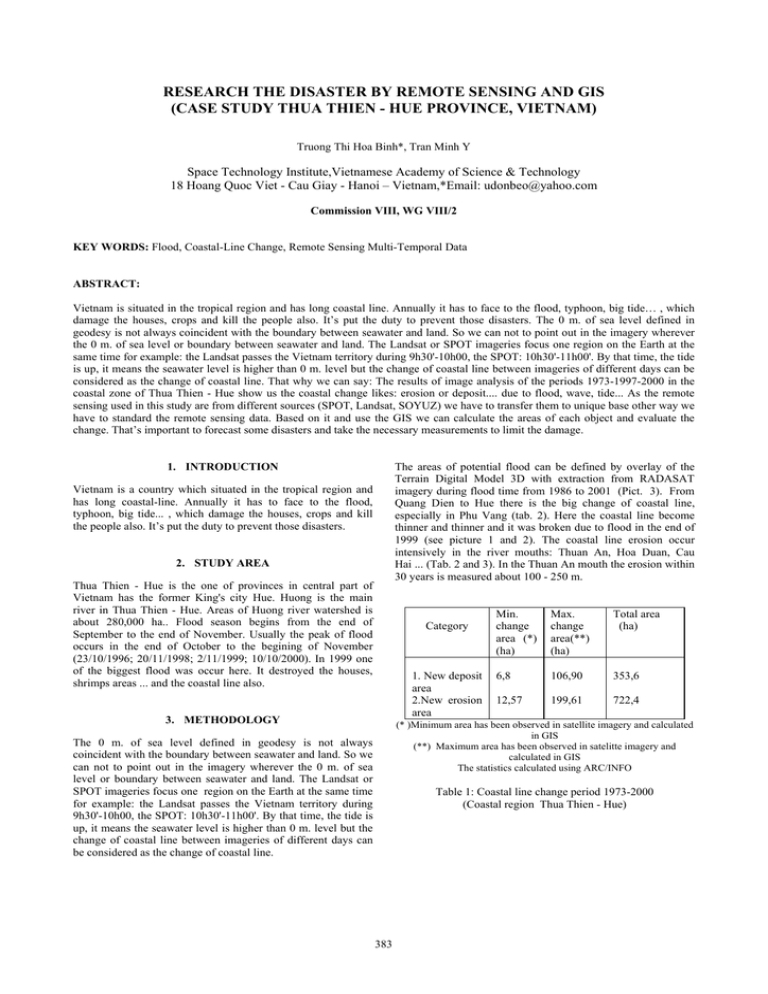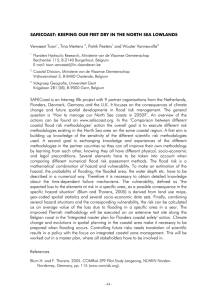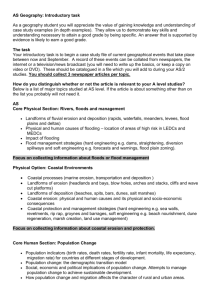RESEARCH THE DISASTER BY REMOTE SENSING AND GIS
advertisement

RESEARCH THE DISASTER BY REMOTE SENSING AND GIS (CASE STUDY THUA THIEN - HUE PROVINCE, VIETNAM) Truong Thi Hoa Binh*, Tran Minh Y Space Technology Institute,Vietnamese Academy of Science & Technology 18 Hoang Quoc Viet - Cau Giay - Hanoi – Vietnam,*Email: udonbeo@yahoo.com Commission VIII, WG VIII/2 KEY WORDS: Flood, Coastal-Line Change, Remote Sensing Multi-Temporal Data ABSTRACT: Vietnam is situated in the tropical region and has long coastal line. Annually it has to face to the flood, typhoon, big tide… , which damage the houses, crops and kill the people also. It’s put the duty to prevent those disasters. The 0 m. of sea level defined in geodesy is not always coincident with the boundary between seawater and land. So we can not to point out in the imagery wherever the 0 m. of sea level or boundary between seawater and land. The Landsat or SPOT imageries focus one region on the Earth at the same time for example: the Landsat passes the Vietnam territory during 9h30'-10h00, the SPOT: 10h30'-11h00'. By that time, the tide is up, it means the seawater level is higher than 0 m. level but the change of coastal line between imageries of different days can be considered as the change of coastal line. That why we can say: The results of image analysis of the periods 1973-1997-2000 in the coastal zone of Thua Thien - Hue show us the coastal change likes: erosion or deposit.... due to flood, wave, tide... As the remote sensing used in this study are from different sources (SPOT, Landsat, SOYUZ) we have to transfer them to unique base other way we have to standard the remote sensing data. Based on it and use the GIS we can calculate the areas of each object and evaluate the change. That’s important to forecast some disasters and take the necessary measurements to limit the damage. The areas of potential flood can be defined by overlay of the Terrain Digital Model 3D with extraction from RADASAT imagery during flood time from 1986 to 2001 (Pict. 3). From Quang Dien to Hue there is the big change of coastal line, especially in Phu Vang (tab. 2). Here the coastal line become thinner and thinner and it was broken due to flood in the end of 1999 (see picture 1 and 2). The coastal line erosion occur intensively in the river mouths: Thuan An, Hoa Duan, Cau Hai ... (Tab. 2 and 3). In the Thuan An mouth the erosion within 30 years is measured about 100 - 250 m. 1. INTRODUCTION Vietnam is a country which situated in the tropical region and has long coastal-line. Annually it has to face to the flood, typhoon, big tide... , which damage the houses, crops and kill the people also. It’s put the duty to prevent those disasters. 2. STUDY AREA Thua Thien - Hue is the one of provinces in central part of Vietnam has the former King's city Hue. Huong is the main river in Thua Thien - Hue. Areas of Huong river watershed is about 280,000 ha.. Flood season begins from the end of September to the end of November. Usually the peak of flood occurs in the end of October to the begining of November (23/10/1996; 20/11/1998; 2/11/1999; 10/10/2000). In 1999 one of the biggest flood was occur here. It destroyed the houses, shrimps areas ... and the coastal line also. Category 1. New deposit area 2.New erosion area 3. METHODOLOGY Min. change area (*) (ha) Max. change area(**) (ha) Total area (ha) 6,8 106,90 353,6 12,57 199,61 722,4 (* )Minimum area has been observed in satellite imagery and calculated in GIS (**) Maximum area has been observed in satelitte imagery and calculated in GIS The statistics calculated using ARC/INFO The 0 m. of sea level defined in geodesy is not always coincident with the boundary between seawater and land. So we can not to point out in the imagery wherever the 0 m. of sea level or boundary between seawater and land. The Landsat or SPOT imageries focus one region on the Earth at the same time for example: the Landsat passes the Vietnam territory during 9h30'-10h00, the SPOT: 10h30'-11h00'. By that time, the tide is up, it means the seawater level is higher than 0 m. level but the change of coastal line between imageries of different days can be considered as the change of coastal line. Table 1: Coastal line change period 1973-2000 (Coastal region Thua Thien - Hue) 383 The International Archives of the Photogrammetry, Remote Sensing and Spatial Information Sciences. Vol. XXXVII. Part B8. Beijing 2008 Distric Deposit area (ha) 197319992000 2000 Erosion area (ha) 197319992000 2000 Quang Dien Huong Tra Hue city Phu Vang Phu Loc Total 106,4 45,5 0 0,4 5,4 179,5 37,6 35,7 165,9 35,8 353,6 17,7 0 18,1 317,2 220,3 722,4 11,0 70,6 154,9 Remote Sensing Data Preparation of image and data Geometric correction to map projector Table 2: Deposit and erosion areas in 6 coastal districs Coastal region Mounth Thuan An region Coastal line from Thuan An to Cau Hai Cau Hai gulf Deposit area (ha) 197319992000 2000 32,5 0,5 Erosion area (ha) 19731999-2000 2000 189,7 51,5 6,8 4,3 135,3 44,2 0 0 51,6 31,1 Preprocessing and enhancement of image Interpretation of RS image Supervise Classification Put the Interpretation result to base map Transfer classified image to GIS in raster. Digitise result map to the GIS Vectorize classified image in GIS software Table 3: Deposit and areas in different coastal regions 4. CONCLUSION Remotely Sensed imagery is one of effective, objective and rapid tool independent on the weather is used for research and monitoring the disaster in watershed. REFERENCE Remote Sensing Note.Japan Association on Remote Sensing, Tokyo, 1991 Edit the content of map follow the theme of establish map ESA, ESRIN. First ERS Thematic Working Group Meeting on Flood Monitoring. 26-27 June, 1995 - ESRIN, Frascati – Italy Malaysian Centre for Remote Sensing (MACRES). Microwave Remote Sensing Research and Development Program. Kuala Lumpur, Dec. 2000 Pre-print work Establish thematic map Technological procedure 384








